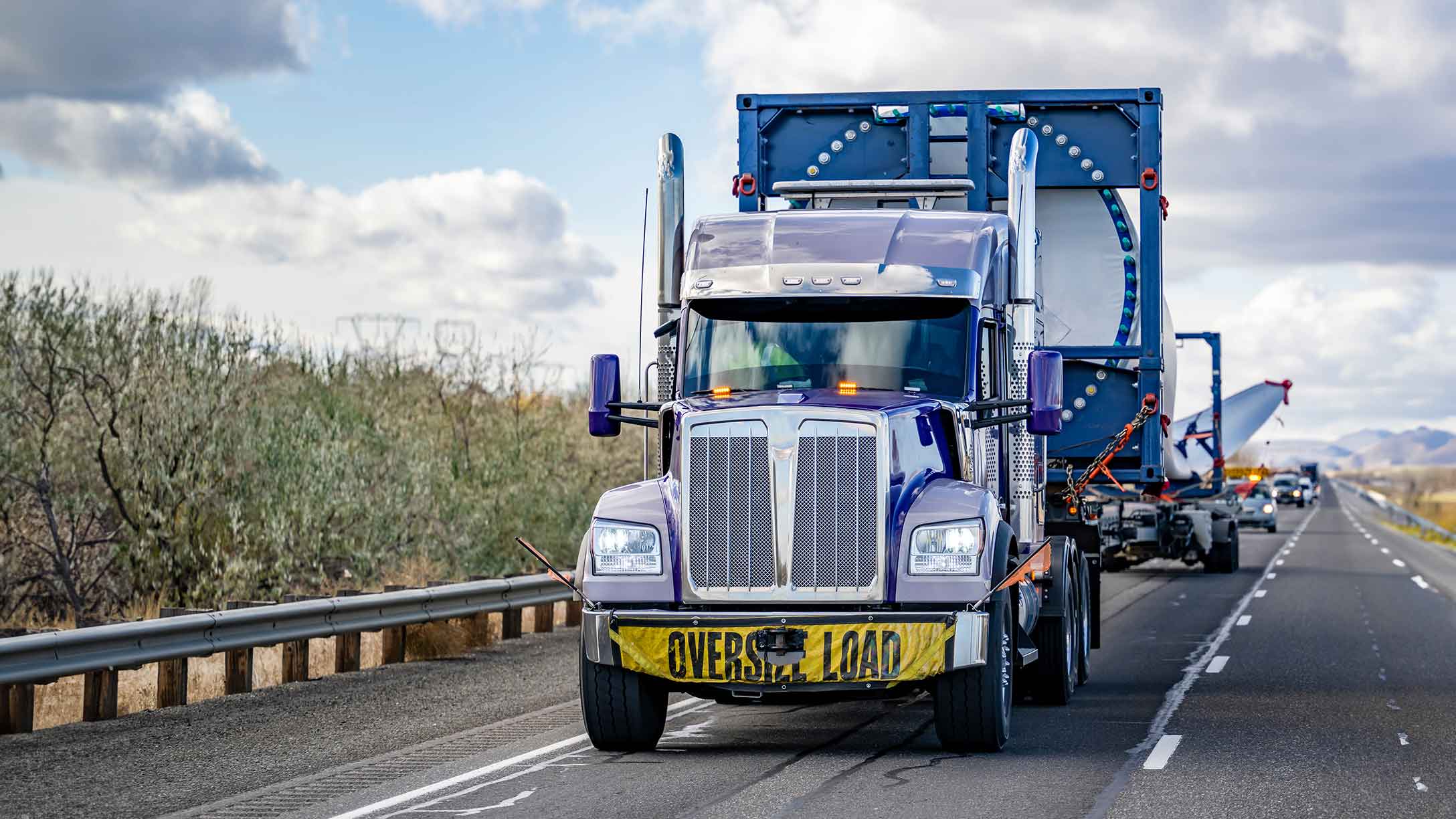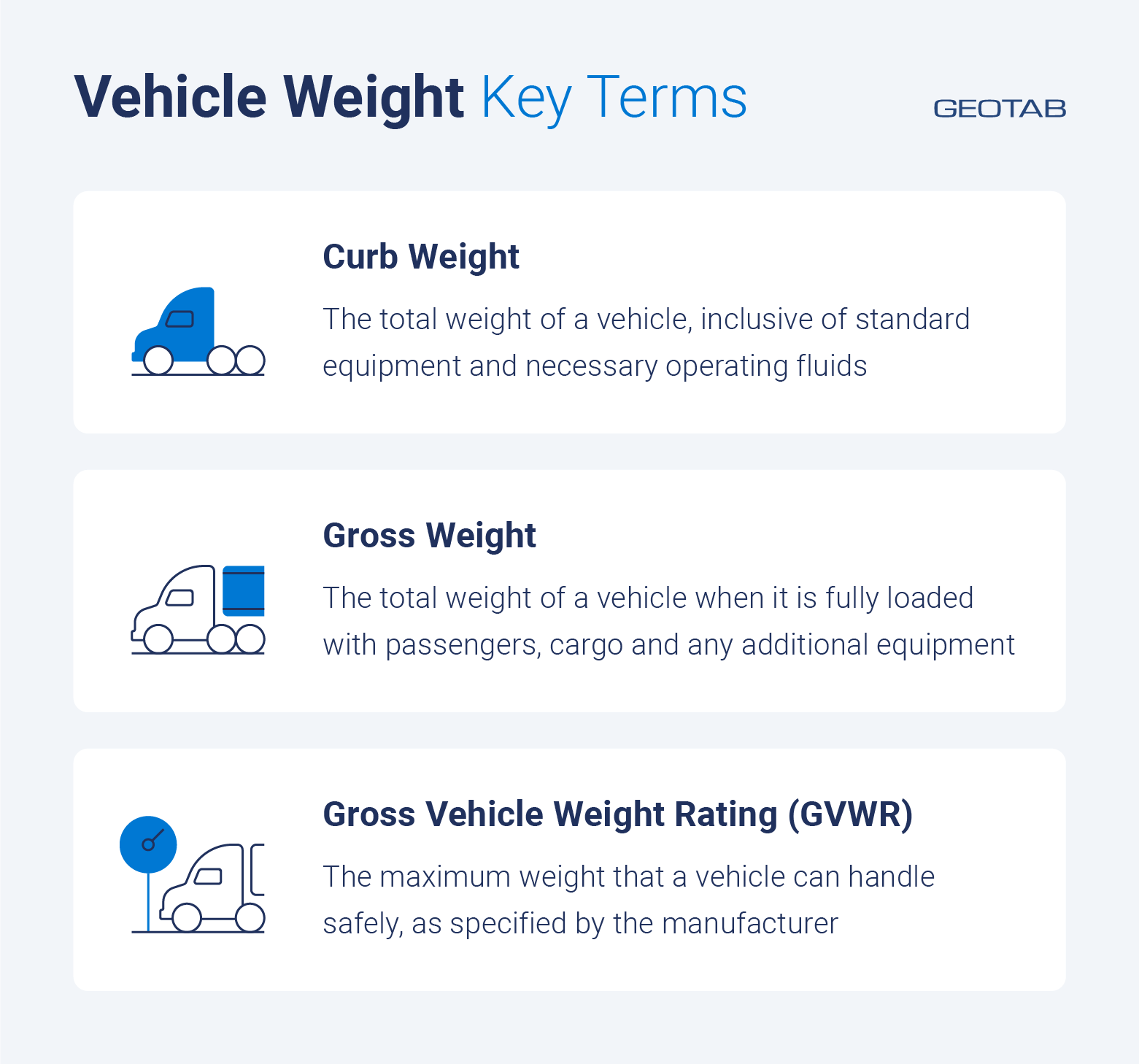Curb weight vs. gross weight: A comprehensive guide to better vehicle performance and compliance
Explore the critical role of curb weight, gross weight and GVWR in optimizing fleet safety, performance, legal compliance and more.

Content Marketing Manager • Corporate Marketing
Jul 21, 2025

Key Insights
- Curb weight is the empty vehicle weight; gross weight includes all cargo and passengers.
- GVWR sets the safe weight limit; exceeding it risks damage and accidents.
- Knowing these weights helps you comply with safety laws and avoid fines.
- Managing weight improves fuel efficiency and reduces wear on your fleet.
Grasping the specifics of vehicle weights — curb weight, gross weight and gross vehicle weight rating (GVWR) — is more than a technical exercise. It’s a strategic move that boosts fleet safety, performance and legal compliance across many industries, including heavy equipment transport.
While these terms may seem like jargon, understanding them is crucial for effective fleet management.
This blog will serve as your guide to unraveling these terms and their importance. We’ll explore how weights influence vehicle performance, their relevance to safety regulations and why fleet managers should keep a close eye on them.
Understanding vehicle weights: Key terms

Let’s start by defining the key terms related to vehicle weights:
Curb weight
Curb weight refers to the total weight of a vehicle, inclusive of standard equipment and necessary operating fluids such as motor oil, transmission oil and brake fluid, but without passengers or cargo. It’s essentially the weight of a ready-to-drive vehicle without any load.
Gross weight
Gross weight denotes the total weight of a vehicle when it is fully loaded with passengers, cargo and any additional equipment. Gross weight is the sum of the curb weight and the additional load.
Gross vehicle weight rating (GVWR)
The GVWR is a capped weight that should never be exceeded. It’s the maximum weight a vehicle can handle safely, as specified by the manufacturer. This weight includes all components of the vehicle, passengers and cargo, but excludes any trailers hitched to the vehicle.
What is curb weight?
Curb weight is a vehicle’s base weight with all standard equipment, necessary fluids and a full fuel tank, but without passengers or cargo.
This measurement affects many aspects of performance, including:
- Fuel efficiency: Lighter vehicles need less power to move, so they consume less fuel and help increase fuel efficiency across your fleet.
- Acceleration: Less weight means less inertia, allowing the vehicle to speed up faster.
- Stability: Heavier vehicles often feel more stable in bad weather or on rough roads.
Curb weight is a starting point for understanding how much load a vehicle can safely carry. It plays a key role in performance, fuel economy and overall handling.
What is gross weight?
Gross weight is the total weight of a vehicle when it’s fully loaded. This includes:
- The vehicle itself
- Passengers
- Cargo
- Fuel
- Any extra equipment or accessories
Understanding gross weight is essential for safe and efficient operations. It affects:
- Safety: Exceeding gross weight limits increases the risk of accidents and endangers the driver, passengers and others on the road. Check out how to build a fleet safety program.
- Performance: Heavier loads impact fuel efficiency, acceleration, braking and handling.
- Maintenance: Overloading leads to more wear and tear and shortens the vehicle’s lifespan. It can also cause tires to fail faster if they aren’t rated for the load, which is why DOT tire regulations require commercial vehicles to use tires with proper load ratings.
Gross weight is also regulated by law. Operating a vehicle over its stated gross weight is unlawful and can result in fines or penalties.
For fleets, monitoring and managing gross weight is a key part of staying compliant, protecting assets and maintaining safe, reliable operations.
What's the difference between curb weight and gross weight?
Curb weight and gross weight both measure vehicle weight but serve different purposes.
- Curb weight is a constant figure. It reflects the vehicle’s weight without passengers or cargo and influences fuel efficiency and performance.
- Gross weight is variable. It includes everything loaded onto the vehicle and determines payload capacity, affecting tire pressure, suspension and braking.

Fuel weight that can be saved by opting for a different sized vehicle.
Understanding these weights has real-world benefits. Knowing curb weight helps fleet managers choose the right vehicle for each job and optimize fuel efficiency. Knowing gross weight ensures loads stay within safe limits, protecting vehicle components and meeting legal requirements.
Modern fleet data analytics tools make it easier to track these metrics in real time and uncover trends that impact cost and compliance.
GVWR vs. curb weight
Gross vehicle weight rating is a term set by the manufacturer that refers to the maximum total weight a vehicle is rated to safely carry, including its own weight and the weight of passengers, cargo and any optional equipment. It's the highest safe operating weight of the vehicle and should never be exceeded.
The difference between curb weight and GVWR is the vehicle's payload capacity.
Exceeding the GVWR can strain the vehicle's engine, brakes and transmission, leading to increased maintenance costs and decreased vehicle lifespan. In a worst-case scenario, it could even lead to brake failure or a blown tire.
Put weight knowledge into action for a safer, more efficient fleet
Understanding the differences between curb weight, gross weight and GVWR helps you operate your fleet safely, efficiently and within the boundaries of the law. The ability to differentiate these weights and apply that knowledge practically can enhance your fleet management strategies.
From optimizing vehicle performance to avoiding potential legal issues, these weights can offer valuable insights and a deeper understanding of the mechanics behind the vehicles you operate.
Ready to translate theory into practice and see how these concepts shape real-time fleet operations? Book a demo with one of our experts today.
Subscribe to get industry tips and insights
Frequently Asked Questions
Yes, curb weight is the actual weight of a vehicle in running condition with standard equipment, fluids and a full fuel tank, but without passengers or cargo.
The curb weight of a vehicle is usually listed in the vehicle's owner's manual. If it's not there, you can contact the vehicle's manufacturer or look for a sticker or plate on the vehicle itself, typically located on the driver's side door jamb.
Generally, it's not recommended or legal to increase a vehicle's GVWR. The GVWR is set by the manufacturer based on the vehicle's design and capabilities. Modifications to increase the GVWR can compromise vehicle safety.
Enforcement of GVWR varies by jurisdiction but commonly involves roadside inspections, checkpoints at weigh stations and documentation checks. Officers measure vehicle weight using scales, check cargo against vehicle documentation and impose penalties if the GVWR is exceeded.
Exceeding the GVWR can result in increased wear and tear on the vehicle's tires, suspension and brakes, and could potentially lead to a higher risk of an accident. Penalties can include fines, vehicle impoundment and loss of commercial driving record points.

Content Marketing Manager • Corporate Marketing
.
Table of Contents
Subscribe to get industry tips and insights
Related posts

Collision avoidance systems: How fleets prevent incidents and improve safety
December 23, 2025
5 minute read

.jpg)
Go beyond reactive truck maintenance with predictive solutions that drive profits
December 8, 2025
3 minute read

Telematics device cost: Key factors that determine pricing
November 19, 2025
5 minute read

Protecting Our Most Precious Cargo: How Telematics is Powering a Safer Ride to School
October 23, 2025
2 minute read
